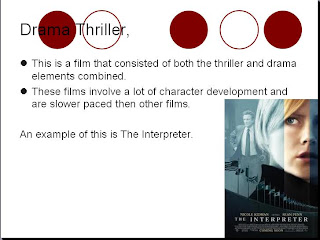Questionnaire Age:
What expectations do you have of a thriller?
………………………………………………………………………………………………………………………………………………………………………………………………………………………………………………………………………………………………………………………………………………………………………………………………………………………………………………………………………………………
Which of the following settings do you think is most likely to appear in a thriller?
· Forest
· Busy City
· Nightclub
In a thriller, should the main character be a protagonist or an antagonist?
…………………………………………………………………………………………………………………………………………………………….
Should the plot be foiled? Antagonists get the better or the protagonists?
…………………………………………………………………………………………………………………………………………………………...
What area should the story be based around? Crime etc.
…………………………………………………………………………………………………………………………………………………………….
Would a double-cross/red-herring be suited to the genre?
………………………………………………………………………………………………………………………………………………………......
Should the main character survive?
…………………………………………………………………………………………………………………………………………………………….
If a crime is the main cause of the thriller, should it be a repeated crime or a one-off?
…………………………………………………………………………………………………………………………………………………………….
Should police be involved in the story?
…………………………………………………………………………………………………………………………………………………………….
Should the person at fault get caught or someone else get stitched up?
…………………………………………………………………………………………………………………………………………………………….
Should the lead character have a ‘sidekick’, and if so, which type of character should it be?
…………………………………………………………………………………………………………………………………………………………….
Above is the empty questionnaire, and below is an example of this questionnaire filled in by someone else
Questionnaire Age: 16
What expectations do you have of a thriller?
I expect a thriller to have crime, murder and escape, James Bond is the ‘landmark’ for thrillers in my opinion.
Which of the following settings do you think is most likely to appear in a thriller?
· Forest
· Busy City
· Nightclub √
In a thriller, should the main character be a protagonist or an antagonist?
I prefer the main character to be a protagonist fighting against the antagonists.
Should the plot be foiled? Antagonists get the better or the protagonists?
I think that in a decent thriller the protagonist always ‘wins’, but that is always the way so maybe if the antagonist is triumphant it would be a shock to the audience.
What area should the story be based around? Crime etc.
I like crime thrillers, especially things like a bank robbery in a packed city, it creates tension among the viewers.
Would a double-cross/red-herring be suited to the genre?
It depends entirely on the storyline.
Should the main character survive?
The main character survives in every film, its common place, however, I’d quite like to see the protagonist survive.
If a crime is the main cause of the thriller, should it be a repeated crime or a one-off?
I think it depends on who the main character is, because if they seem ‘likely’ to repeat it, they should, whereas if they don’t ‘need’ to, they shouldn’t.
Should police be involved in the story?
Yes, it brings extra tension.
Should the person at fault get caught or someone else get stitched up?
I think they should escape and nobody else gets the blame for it.
Should the lead character have a ‘sidekick’, and if so, which type of character should it be?
Yes, I think the sidekick should be a very unlikely character, similar to Shorty in Indiana Jones, the eight year old kid that was just like a mini-me of the protagonist.
I have chosen these questions carefully because all together they begin to build a picture of an idealistic thriller. I added the age part at the top because different age groups might find different things desirable in a film, this way we can see precisely what certain age groups want.
By Ben Marshall

























